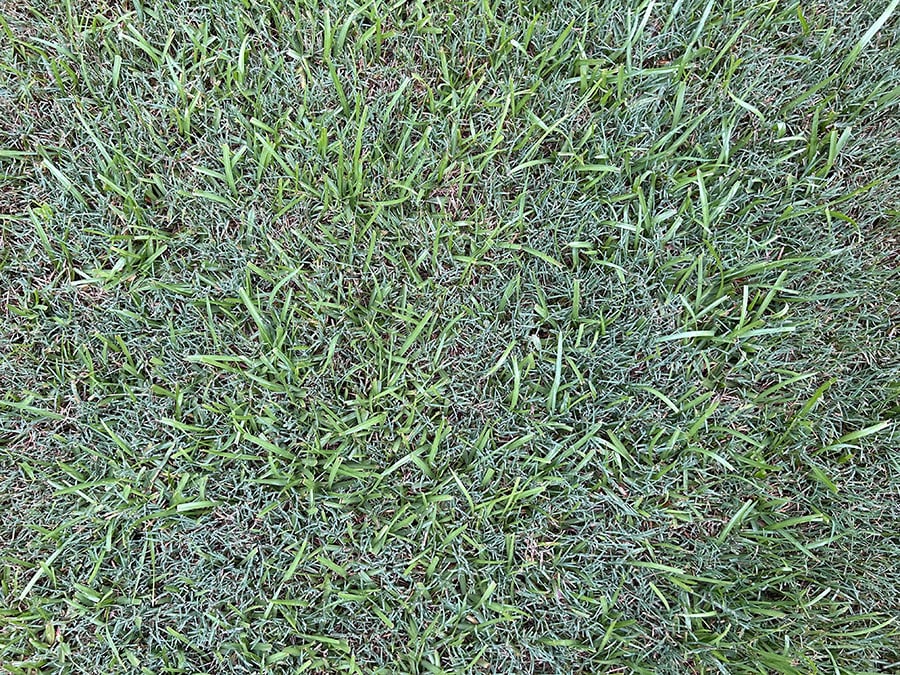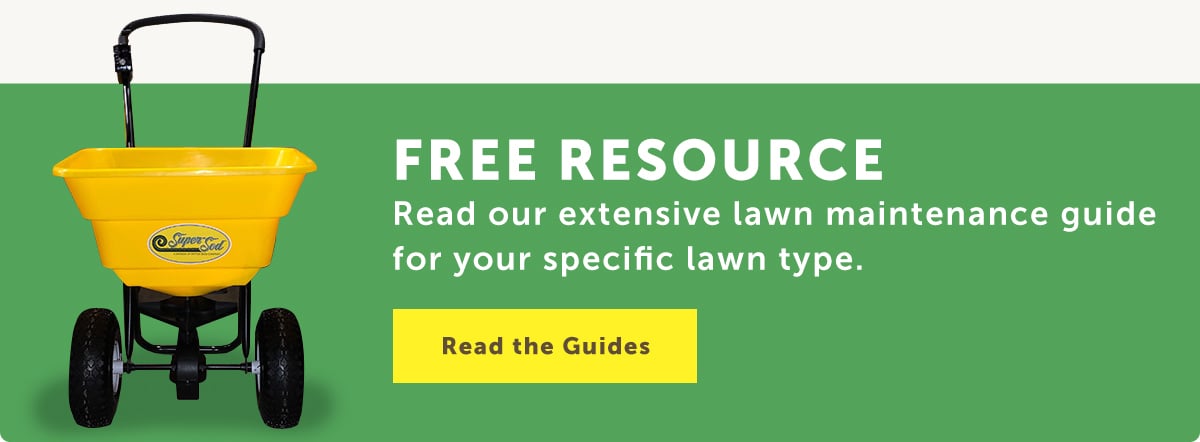

How to Get Rid of Centipedegrass in Bermuda, Zoysia, & Tall Fescue Lawns


If you have Centipedegrass invading your lawn, it’s the easiest turfgrass to eradicate from Bermudagrass, Zoysiagrass, and Tall Fescue lawns.
Centipede grass stands out when intermingling with other lawns and is easy to identify because it’s lighter green, it has a wider leaf blade making it coarser textured than the other turfgrasses, and has an obvious crease down the middle of the leaf blade following the center vein.
You could pull Centipedegrass stolons by hand or spray it out with a kill-all herbicide, but hand-pulling the spreaders is tedious, and the non-selective herbicide will also kill your desired lawn.
However, you’re in luck if you want to get rid of Centipede grass in other lawns because you can literally love it to death!
Option 1: How to Love Centipedegrass to Death
Due to the sensitive nature of Centipedegrass lawns, simply follow a good lawn care fertilization schedule for your warm season Bermudagrass or Zoysiagrass by applying 16-4-8 in the spring and summer growing seasons. The repeat applications of high nitrogen (nitrogen is the 16 in the 16-4-8 ratio) will kill the Centipedegrass over time.
Same for Tall Fescue, but it’s a little trickier. Since Tall Fescue is a cool season lawn, it’s actively growing in the cool months. Thus, a high nitrogen fertility regimen using 16-4-8 will only set back Centipede grass in the cooler months of spring and fall when it’s safe to fertilize Tall Fescue (from September to April).
To explain the issue a little further, in our monthly lawn care tips we recommend low nitrogen 5-10-30 fertilizer for Centipedegrass only twice a year (nitrogen is 5 in the 5-10-30 ratio) because Centipede is so incredibly sensitive to nitrogen. In fact, do-it-yourself homeowners and applicator companies have been known to accidentally kill Centipede grass lawns with too much nitrogen (such as what's found in 16-4-8). The flip side is you can make this sensitivity work to your advantage when you want to get rid of it in your Bermuda, Zoysia, or Tall Fescue lawn!
Since 5-10-30 is safe for Centipedegrass, to eradicate it from other lawns, we recommend 16-4-8 because that's triple the amount of nitrogen and the Centipedegrass will not like all that nitrogen!
Option 2: Two Options for Chemical Eradication
1) Selective Herbicide with Quinclorac as the active ingredient
Centipede is sensitive and susceptible to applications of any herbicide containing Quinclorac, especially when temperatures are warm (when nighttime temperatures are above 65 degrees) and a surfactant is used. More than one application may be necessary.
Most Zoysias, Bermudas, and Tall Fescue blends are tolerant and resilient to Quinclorac; Bermuda may turn yellow but it will survive. You can either let a discolored lawn recover and green up on its own (it will!) or you can help it out by applying nitrogen with iron. I reach for liquid nitrogen with iron, such as Ironite.
2) Non-Selective Herbicide & Sod Replacement
This option is best used when the Centipede grass infestation is limited to certain areas of the lawn.
Using a non-selective herbicide (one that will kill any plant it touches - many options are available at big box stores), spray the lawn infested with Centipedegrass. This might take several applications over a couple weeks to ensure that the Centipede is in fact dead; however, Centipedegrass is also very sensitive to chemicals and it should die out easier than other turfgrasses, such as Bermudagrass.
Once you are sure the Centipedegrass is killed, till the area, then rake out remaining dead vegetation. Spread a layer of Soil³ compost, till in the compost, then lay your newly purchased Bermuda, Zoysia, or Tall Fescue rolls in the area. Keep it watered until your new lawn is rooted.
We sell sod by individual rolls to make patching areas easier for you. Each roll covers 10 square feet.
Option 3: Design Solutions
If your lawn touches up with a neighbor’s Centipedegrass lawn and you don’t want to deal with repeatedly fussing over the intermingling lawns, you could put a flower bed between your lawn and your neighbor’s. The purpose of a bed is to add a physical barrier that you maintain by mechanically or chemically edging around the bed to stop different turfgrass runners from intermingling.
Amend your new bed with Soil³ compost and plant anything from flowering shrubs, annual and perennial flowers, to small flowering trees and even vegetables!
This picture shows a flowering bed with an edge maintained by spraying herbicide to stop runners from spreading into it. The brown rim around the lawn is where herbicide was sprayed. The dead rim will eventually die out, becoming a clean edge.
Option 4: Manual
Because Centipede grass does not have any rhizomes*, hand pulling is a tool in your eradication toolbox. For small infestations, manually pulling out Centipedegrass stolons** can be effective. This method is labor-intensive but avoids the use of chemicals.
I would not spend my time teasing out Bermuda grass or Zoysia grass stolons and rhizomes from each other. However, if there were a small area of Centipede runners in my desired lawn and there were a podcast I was particularly addicted to, you might find me on the ground trying to dig out a few Centipede grass runners (only because there are no rhizomes to contend with!).
*Rhizomes are underground spreading stems and are very hard to pull up by hand.
**Stolons are like rhizomes, but they are the above-ground horizontal stems that you can see; they are also called runners or spreaders. Since they are above ground, they area easier to pull up by hand, but still a bit of a challenge that requires a hand weeding tool.
Option 5: Live With it!
Centipede can coexist okay with other lawns, but I personally don’t like the height, color, and texture differences as seen in the picture at the top. The Centipede blades contrast too much and stand out more than I am able to tolerate.
If you choose to live with it, I am confident that the Centipede runners will eventually die out through the years as you continue fertilizing your desired lawn with nitrogen and applying post-emergent herbicide as part of your typical lawn care plan. As established above, Centipede grass is so sensitive that nitrogen fertilizer and herbicide will kill it.
If it were me, I would go the easiest route of getting rid of Centipedegrass in my warm season or Tall Fescue lawn by loving the Centipede to death. Your lawn will look stunning as a result of the regular fertilization and it will really do a number on that nitrogen-sensitive Centipede grass lawn. Plus, a properly fertilized Bermuda or Zoysia lawn should outcompete the invading Centipede lawn.
We hope these five options help you attain the Bermuda, Zoysia or Tall Fescue lawn of your dreams. If you have remaining questions, don’t hesitate to ask them here!





